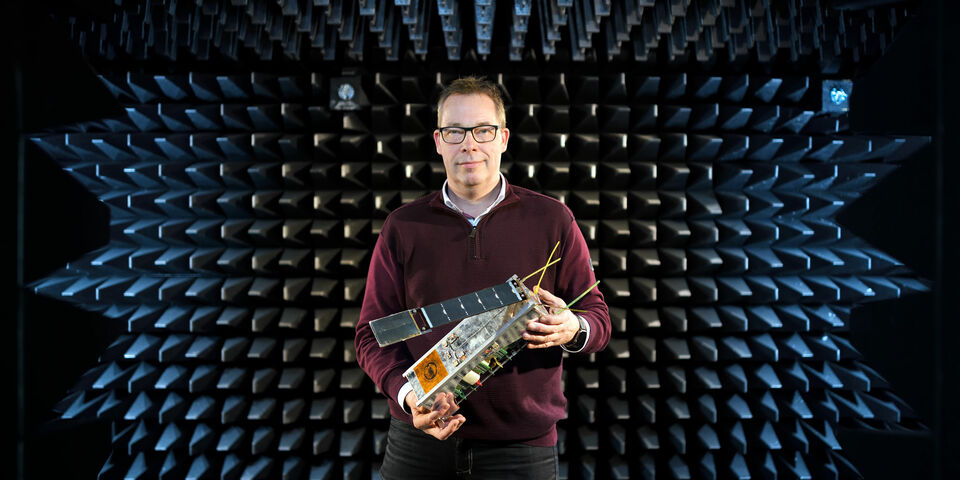Prof Talk | Listening to signals coming from space
“The thirty million from Minister Van Engelshoven guarantees that we can participate in building an international project that we ourselves initiated,” says Mark Bentum, TU/e professor of Radio Science. Last week in her science letter to the Lower House, the Minister of Education, Culture and Science (OCW) stated her intention to invest in the construction of the world's largest radio telescope. What makes this telescope so special, what purpose is it being built to serve and what role will the Netherlands be playing?
Several countries are currently busy securing financing for the construction of the Square Kilometer Array (SKA), two antenna fields containing more than a hundred thousand antennas in South Africa and Australia, which are intended to jointly form the largest radio telescope in the world tuned to a wide frequency range. OCW Minister Ingrid van Engelshoven has promised to earmark thirty million euros as the Dutch share of the total costs, which are expected to be nearly seven hundred million euros.
According to Mark Bentum, professor of Radio Science at the Department of Electrical Engineering, this means that the Netherlands will continue to be a fully-fledged partner throughout SKA's construction phase. “We played a very important role in the development phase. Many decades ago ASTRON, the Netherlands Institute for Radio Astronomy, developed the LOFAR (LOw Frequency Array, ed.), the first large-scale radio telescope consisting not of dishes but of flat antennas. It is still unique and it's an achievement we should be proud of. This technology will be used in the SKA. We were one of the parties that initiated SKA; now an international consortium has been set up because we cannot do this alone and, let's be honest, the Netherlands isn't the best place to site a telescope like this one.”
Early universe
When performing radio astronomy on a significance scale, both the number of antennas - the greater the number of antenna systems, the more sensitive the reception and the weaker the sources that can be detected, such as those from the very early universe - and the size of the total receiving surface area are important considerations. Making lots of small antennas and placing them thousands of kilometers apart creates an optimum balance. Taken together, the antenna fields in South Africa and Australia - “In the middle of nowhere and then some,” as Bentum says - will soon create a receiving surface area measuring a square kilometer. And whereas a traditional dish can receive signals emitted only from the region it is trained on, with its antennas the SKA can ‘listen’ to the entire universe.
Bentum is enthusiastic about the new possibilities the SKA opens up and guarantees the findings will be spectacular. “We want to chart the very early universe. What happened just before and after the Big Bang? We are going to study pulsating stars and mysterious fast radio bursts - short but very strong radio signals that have been observed recently. We have no idea what they are and where exactly they come from. We are going to watch the planets orbiting other stars and we hope to be able to say something insightful about extraterrestrial life. We'll be able to measure whether a magnetic field is present and determine the composition of an atmosphere, if there is one. Isn't it marvelous that we'll be contributing to these discoveries!”
Swarm of antennas
TU/e is among those working - as yet on a small scale, but Bentum hopes to see expansion soon - on developing the SKA project, and on the next step: radio astronomy in space. A swarm of antennas far away from the earth would function as a low frequency radio telescope, without the disruptions here on earth created by the ionosphere and radio communication signals. Research on a new instrument for this purpose, OLFAR (Orbiting Low Frequency ARray) is in full swing in Bentum's group.
But first things first, there's the SKA to build. Bentum: “Two of our PhD candidates are at Curtin University in Perth, Australia researching issues related to the antennas. How do you calibrate your instrument? How can you ensure that your instrument is set up optimally to answer a particular research question? The Netherlands is strong in the antenna field; Dutch companies are also participating in the procurement process for the actual construction so, who knows, perhaps Dutch SKA antennas will soon be scanning the universe. Once the telescope is operational it will give rise to gigantic data streams, and these will need to be processed by supercomputers in science centers all over the world. One such science center will be built in the Netherlands. Where, who and how are still unanswered questions, but if I have anything to do with it, as TU/e we will certainly have a role to play.”


Discussion